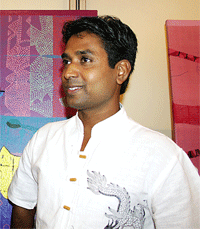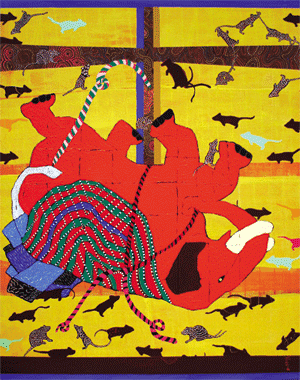- Prelude
- Guest Editor’s Column
- Creative Impulse
- Horloges : Counting The Hours
- Aesthetic Movement: Aesthetic furniture
- Book Review
- Engraving Deeper Thoughts:
- In the News
- Artist Index and Statistics
- Market Insight
- Auction Reports
- Photo Feature
- The month that was
- Mumbai Artsighting
- Art Bengaluru
- Musings from Chennai
- North-East Opsis
- In between – from Vadodara
- Deccan Odyssey
- Inscriptions in Bronze
- Writing Visuals
- A Missing History: The Other Story Re-visited
- Invisible Cities
- His Story
- Erasing Borders Exhibition of Contemporary Indian Art of the Diaspora
- Urban Testimonies
- The Medium Speaks Back
- Indian Art & Fashion goes to Sweden
- Mahanagar@Kolkata
- Different hues of Aakriti
- Christie’s : Important Watches Hong Kong
ART news & views
Creative Impulse
Volume: 2 Issue No: 6 Month: 7 Year: 2010
Dhaneshwar is a young adventurous artist with an inherent urge for experimentation. Having earned several awards & scholarships and several successful shows later he keeps his humble boy next door demeanor well in place. Predominant tribal inspiration juxtaposed with miniature tradition where perspective and scale are acquiescent and are used to compliment the central character. The works stand out bold and entertaining with a tinge of humour, & positivity…
His solo “Longings of the Earth” in Singapore (Indigo Blue) and New Delhi (Art Konsult)
& the ecstatic response towards his body of work reaffirmed his conviction…
 |
Q. Your show proved to be a success yet again, despite the market low last year, comment..
DS. I do not understand the particular meaning of success. I know only that I finished my duty with honesty. I tried to create some pure, good quality and creative works. People have appreciated and accepted my language. This understanding of my work gives me strength on an intellectual plane as an artist.
a
That is enough for me.
Q. You began with images of city life in your work which rapidly transcended to an almost affectionate portrayal of animals, any particular reasons?
DS. My earlier works were a result of the direct influence of the immediate world around me. I forget the first time I drew and painted an animal form but I am sure of those forms in my childhood doodles done on walls, buried deep in various whitewash layers might be still there and breathing, I guess.
I remember in our life study classes in my college days, the human model used to pose like a dead man unlike the birds on windows that were more inspiring and alive. I started to study those bird forms; they had a feel of motion. They were more spontaneous and energetic, with varied expression, energy &, power, more symbolic. They gave me a chance to outdoor study & experimentation.
I got my way.
Q. The elephant (showcased in many articles and also on the cover of ASIAN ART NEWS)
what brought about that perception?
DS. “Art does not reproduce the visible” - Klee
The meaning of art is to discover the unknown and inexperienced possibilities of the world unlike they appear/exist.
This is a totally humorous art work and with a simple meaning/story. It is related with the story of “ALI BABA, CHALIS CHOR” the elephant represent: Ali Baba and the rats symbolize challis chor, in my version of the story.
Q. Your visit to Bastar and tribal regions seems to have had tremendous influence on your style. This Bastar experience shows vividly in your works yet they are very contemporary..
DS. It opened my eyes when I finished my college and travelled to Bastar. I have made a short film on bastar's tribal art. There I saw the real art taking shape created by Bastar tribals. I saw that these native people of Bastar had an inherent value of art in them. They inspired me with their technique to simplify their art and with a natural flair within their limitations. After I came back I realized most of the great art of the world has evolved out of tribal art.
I had always sought a new direction/language for my work. Neither do I want to forget culture /tradition, nor can I ignore the neo modern time. Through these experiments I tried to create a balance between culture/tradition and modernism.
The tribal art influenced my work and I started using the dotted lines, thick outlines, bright and flat colors, humor, repetition of forms etc. Solid outlines I use in my paintings to create volume of the form. The bright colors I use in various hues and also monochromatic colours for a dramatic effect. The main form in my painting comes out with thick colors while the background is always textured and smooth. The repetition of forms is a tribal and miniature concept. But I use this concept in a multiple personality aspect. You need to discover various dimensions of the same form at one place and put them together. Like lord Krishna dancing with Radha.
 |
Q. You earned several residencies abroad, Italy, Africa, Australia and China, how do you perceive their influence...?
DS. In the year of 2007, I traveled to Australia and Tanzania to study aboriginal art in a residency programme. I was highly influenced by aboriginal philosophy and their work. A great philosophy like “Dreaming” inspired me.
I found one thing quite interesting, Indian and other tribal arts are very similar in terms of approach and concepts. And I was really curious about it.
Q. Any particular learning experiences?
DS. As I know myself, whenever I traveled to new places, my perception imbibed with new visuals and experiences, they enter my mind consciously and unconsciously, finally in my practice is conceived a new different style. I think travel is a very nice way to learn many things with lots of new different experiences and I have learnt many things from my past residency like:
Australia: aboriginal art from aboriginal artist
Tanzania: tinga tinga art from the tinga tinga artists, few techniques of paper making with natural fibre.
Italy: research work on mask making
China: the study of “Tao art”.
Q. Unlike most contemporary works your works project a feeling of elation and wellness, inspiring cheer & positivity!!
DS. It happens spontaneously, I think, the canvas /paper is a sort of a play ground, I play/enjoy within like a infant.
Q. Talk about the Denmark show coming up?
DS. It is to start around the mid of August and stays for about a month. This art exhibition at the Scandinavian Auction & Gallery is very important for me because it is a new experience for me and a chance for my art work to gain globally….
Q. Your works challenge all rules of space & dimension, creating surreal perspectives.
DS. I like to play with the concept “beauty of scale”. In this concept, smaller gets bigger and bigger gets smaller and the entire composition becomes mysterious and interesting.
These are all essential elements for composition (like a Masala for food). you must need a day by day practice with all these elements after that you can express your idea very clearly with an intelligent approach. The gist of my artwork is the simplification of complex thoughts.
Q. What is the thought process? The justification in today's world with plants (greenery) & animals at the peril of extinction and the human population spreading like a virus on Earth??
DS. Thought processes are related with your past experiences and expectations for future, both give a new direction to your work/ experiment. Animals today are an endangered species and deserve existence, in our day today lives we forget that and they have already ceased to exist in our conscience.…
Q. Future project?
Ds. Recently I have been nominated for the Chinese Govt. Scholarship. For my advance research program related with Experimental Art in China, traditional language conversion, and research on non-material culture heritage and folk art. I shall continue to experiment with varied mediums be it painting or sculpture, installation or video art.